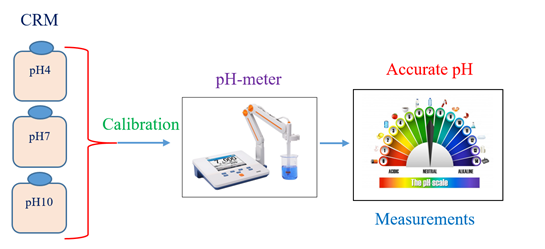JOURNAL 2773
Journal of Chemical Metrology
Year: 2023 Issue: 1 January-June
p.100 - 113
Viewed 2291 times.
GRAPHICAL ABSTRACT

ABSTRACT
The need for certified pH reference materials to support the traceability claims and quality of the daily large volume of pH measurements is very strong. In this work, three batches of buffer solutions were prepared, and their pH values were certified in accordance with the IUPAC Recommendation 2002. The first batch was prepared from potassium tetraoxalate (dihydrate) and disodium oxalate to provide pH4 and the second batch was prepared from disodium hydrogen phosphate and potassium dihydrogen phosphate to provide pH7. The third batch was prepared from sodium hydrogen carbonate and sodium carbonate to provide pH10. Every batch was homogenized by mechanical shaking for one night and bottled into 50 HDPE bottles, each is 250 mL. A number of bottles were systematically selected for homogeneity, stability and characterization studies of the buffer reference materials. These studies were carried out in accordance with the requirements of ISO 17034 and ISO Guide 35 using Baucke cell. The pH values 4, 7 and 10 of the secondary buffers were restandardized with regard to the pH values 4, 7 and 10 of the primary buffers produced by the Slovak National Metrology Institute, SMU. The results obtained showed that the produced buffer RMs were homogeneous and stable enough and their certified pH values were found 4.001±0.019, 7.005±0.015 and 10.002±0.023. These CRMs will be very useful as calibrants and as PT samples for analytical laboratories performing pH measurements in various fields.
KEYWORDS- Buffer batch
- homogeneity
- stability
- Baucke cell
- characterization
- uncertainty